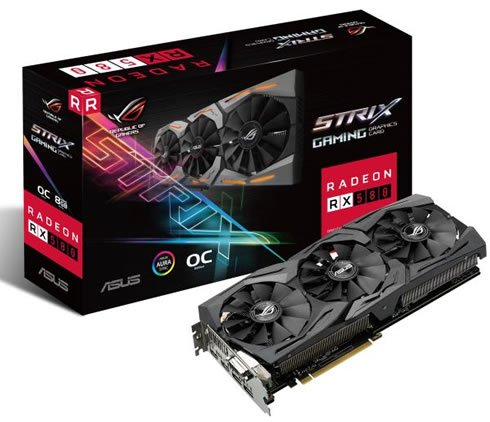
AMD Radeon RX 500 Series Are Launching
Today AMD introduced the Radeon RX 500 series, a new line of graphics cards featuring a powerful combination of improved game performance, higher clock speeds, and a 2nd generation Polaris architecture.
Diving into the cards themselves, we have the RX 580, RX 570, RX 560, and RX 550. These cards will extend from $79 up to $229, launching in waves over the next month.
For the cards based on upgraded versions of existing RX 400 SKUs - primarily the RX 580 and RX 570 - clockspeeds and TDPs are up. Meanwhile towards the lower end of the stack, we're getting a full-enabled Polaris 11 card in the RX 560, or below that, a new low-end GPU in the form of Polaris 12, which is going into RX 550.
The RX 500 series is using new revisions of the existing Polaris 10 and Polaris 11 GPUs. These revised chips have received further tweaking to reach higher clockspeeds, while also fixing a couple of minor issues with the GPUs. AMD is adding a new mid-power memory clock state so that applications that require memory clocks faster than idle - primarily mixed-resolution multi-monitor and video decoding - no longer cause the memory to clock up to its most power-demanding speeds, keeping overall power consumption down.
Meanwhile on the manufacturing front, all of the revised Polaris chips are being manufactured on what AMD is calling the "Latest Generation FinFET 14" process - improvements made by AMD's partners GlobalFoundries and Samsung to their 14nm LPP.
AMD's target market for the new RX 500 cards is owners of existing 28nm cards such as the Radeon 300/200 series, as well as NVIDIA's GTX 900/700 series. The actual performance gains over the RX 400 cards are around 5%, so this isn't meant as an upgrade for owners of those cards.
| AMD Radeon RX 580 (8GB) | AMD Radeon RX 570 | AMD Radeon RX 560 | AMD Radeon RX 550 | |
| Stream Processors | 2304 (36 CUs) |
2048 (32 CUs) |
1024 (16 CUs) |
512 (8 CUs) |
| Texture Units | 144 | 128 | 64 | 32 |
| ROPs | 32 | 32 | 16 | Unknown |
| Base Clock | 1257MHz | 1168MHz | 1175MHz | Unknown |
| Boost Clock | 1340MHz | 1244MHz | 1275MHz | 1183MHz |
| Memory Clock | 8 Gbps GDDR5 | 7Gbps GDDR5 | 7Gbps possibly GDDR5 | Unknown amount of GDDR5 |
| Memory Bus Width | 256-bit | 256-bit | 128-bit | 128-bit |
| VRAM | 8GB | 4GB | 4GB | 2GB |
| Transistor Count | 5.7B | 5.7B | 3B | 2.2B |
| Typical Board Power | 185W | 150W | 60-80W | 50W |
| Manufacturing Process | GloFo 14nm | GloFo 14nm | GloFo 14nm | 14nm |
| Architecture | GCN 4 | GCN 4 | GCN 4 | GCN 4 |
| GPU | Polaris 10 | Polaris 10 | Polaris 11 | Polaris 12 |
| Launch Date | 04/18/2017 | 04/18/2017 | 05/2017 | 04/20/2017 |
| Price | $229 | $169 | $99 | $79 |
The RX 580 is a fully enabled Polaris 10 GPU. AMD is bumping up the boost clock by 6%, from 1266MHz to 1340MHz. Meanwhile the base clock is increasing by 12%, from 1120MHz to 1257MHz.

Meanwhile the memory clock is not changing for the 8GB cards. AMD is holding fast at 8Gbps GDDR5 on a 256-bit memory bus. It should also be noted though that while the default configuration of the RX 580 is 8GB, like the RX 480, some 4GB cards are also expected to be produced.

When it comes to power there's no such thing as a free lunch; TBPs have increased from 150W to 185W in order to allow RX 580 to reach these clockspeeds.
The RX 580 is launching today. 8GB cards will start at $229, while 4GB cards will start at the all-important $199 price point. AMD doesn't even have a reference RX 580 design - board partners are hitting the ground running on factory overclocked cards.
The target market for the RX 580 will be a mix of 1440p and 1080p gaming.
Next up is the Radeon RX 570, which is an enhanced version of the RX 400 series predecessor, the RX 470. This is a cut-down Polaris 10 GPU with 32 of 36 CUs enabled, but again clockspeeds are increased. RX 570 goes from 1206Mhz to 1244MHz on the boost clock, a 3% gain, while the base clock is increased from 926MHz to 1168MHz, a gain of 26%.

The standard memory configuration here will be for 4GB of VRAM, however AMD has mentioned that we should expect to see some 8GB cards as well.
Moving on, TBPs have increased for the RX 570 as well. Whereas the RX 470 was a 120W card, the baseline for RX 570 will be 150W in order to drive the Polaris 10 GPU at higher clockspeeds and to power throttle less often.
The RX 570 will be launching at $169, $10 cheaper than where the RX 470 launched last year. Like the RX 580, the RX 570 is launching in volume today.
The target market for the RX 570 is 1080p gaming.
Third up is the Radeon RX 560. It packs a fully enabled Polaris 11 GPU. The card's boost clock is being bumped up from 1200MHz to 1275MHz (6%) and the base clock from 1090MHz to 1175MHz (8%). Coupled with two additional CUs, we're looking at a performance improvement on paper of around 22%.
When it comes to memory, AMD has only mentioned 4GB cards thus far.
The card's official TBP is 60 to 80W. AMD's partners will be releasing both sub-75W versions that don't require a PCIe power connector, and 75W+ versions that do.
Unlike the RX 580, RX 570, and RX 550, the RX 560 isn't launching this week and it will be launching in early May. Prices on these cards will start at $99.
Last but not least is the Radeon RX 550. At the heart of the RX 550 is AMD's new Polaris 12 GPU. This is an even smaller, lower performance, and lower power GPU than Polaris 11. It features just 8 CUs but a full 128-bit memory bus.

The RX 550 in turn will ship with a Polaris 12 clocked at 1183MHz for the boost clock, while the memory clock is unknown.
The desktop card will come with 2GB of VRAM and will be priced at $79. It will be launching later this week, on April 20th.





















